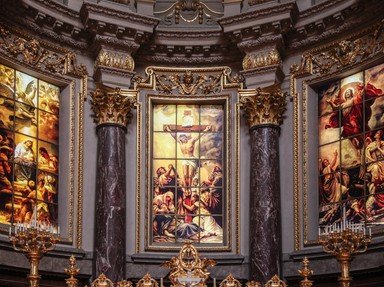Quiz Answer Key and Fun Facts
1. I was a canon lawyer and Chancellor to Edmund Rich, the Archbishop of Canterbury, who had been one of my professors at Oxford. I became a priest after the Archbishop died. I eventually became a well-loved bishop, but I'm best known for writing a prayer that became a hit song in 'Godspell'. I am
2. I was one busy lady! I ran a convent, composed music, wrote poetry, and books on medicine and natural history, and had a lot of visions (about which I wrote a detailed account, with illustrations!). When I wasn't doing any of these things, I was firing off letters to popes and princes, telling them to shape up! I am
3. My name is Patricius, but you know me as St. Patrick. I was born somewhere between the Clyde and the Severn in Western Britain in the 5th century, but I wound up in Ireland. How did I get there?
4. My grandmother was a saint (no, really!), and so were two of my brothers. I lived in what is now Turkey (it was Cappadocia back then) and I'm best remembered for my book 'The Life of Moses' and a collection of sermons I gave, based on the Song of Solomon. I am
5. I was a successful lawyer when, much to my surprise, after a passionate speech I gave at a synod to elect a new bishop, I was the one who got elected. Not only was I a layman at the time of my election, I wasn't even baptized! That was seen to in very short order, however, and my consecration followed immediately thereafter. All this took place in 374. I am most noted for the influence I had over Augustine of Hippo, which brought about his conversion to Christianity. I am
6. I'm responsible for the introduction of the word tawdry into the English language. It's a corruption of Audrey, the Anglicized version of my Anglo-Saxon name. I was an Anglo-Saxon princess who remained a lifelong virgin, despite two marriages! After my second husband died, I founded a monastery at Ely and died there in 679.
7. I was a lawyer, an intellectual, an author (in fact one of my books is still required reading for some university courses), and eventually became the Lord Chancellor to the King. However, he and I fell out over a matter of religious principle, and I lost my head. I am
8. I was another Anglo-Saxon princess (one of the few whose name didn't begin with Ethel, it seems). I was ardently courted by a neighbouring prince, but I fled from him. He pursued me, but was struck blind. He regained his sight after I prayed for his sight to be restored, and he was so grateful he left me alone. I went on to found a double monastery (for both monks and nuns) on the site where one of the colleges of one of the two leading English universities now stand. I eventually became the patron saint of that university town. I am
9. No one knows very much about my life, but every Londoner and many tourists coming into London by train know my name. I am
10. I can't do a quiz about saints without a question about a Welsh saint (the Welsh hills are alive with the sounds of saints' names, believe me. Wales has almost as many saints as it has rugby players!) Here goes: I lived in Flintshire, in North Wales, and I was a niece of St. Bueno. He raised me to life after my head had been cut off by a spurned suitor. A well bubbled up just where my head had fallen and it was the site of many miraculous cures. I entered a convent and took the veil. After my (second) death, a shrine dedicated to me was built there, and it became a place of pilgrimage, called Holywell in English. In the 12th century my relics were moved to Shrewsbury, and it, too, was a place of pilgrimage. I am
Source: Author
Cymruambyth
This quiz was reviewed by FunTrivia editor
Exit10 before going online.
Any errors found in FunTrivia content are routinely corrected through our feedback system.
